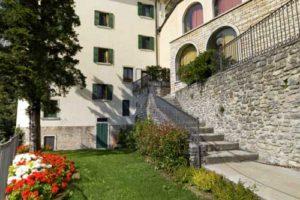Overview
The Madonna della Corona Sanctuary is located in Spiazzi in one of the most picturesque locations in northern Italy.
Rises clinging on the rock of the mountains that surround it, at 774 meters above sea level, overlooking the valley of the Adige river.
Historical notes about Madonna della Corona Sanctuary near Verona
The Shrine of the Madonna della Corona is a place of silence and meditation, extended between heaven and earth, hidden in the heart of the Baldo rocks. Medieval documents testify that hermits linked to the Abbey of St Zeno in Verona lived in the Baldo area already around the year 1000 and that at least from the second half of the 13th century there was a monastery with a chapel dedicated to St Mary of Montebaldo.

Coming to Verona and having the best stay:
- Compare prices of hotels in Verona, for all pockets or view hotel deals at the bottom of the page that we have for you. You can also stay at The Hotel Residence Stella Alpina, it is a property of the Madonna della Corona sanctuary, which is located about 150 meters from the center of Spiazzi in a magnificent mountain scenery, on a terrace overlooking the Val d’Adige below. It is open from March to November with service restaurant, bar and hotel.
- Find cheap flights to Verona Villafranca Airport
- Here is a selection of Travel guides for Verona
.
- And something else for you, selection of:
Guides and tours in Verona:
See our Top 15 catholic shrines around the world.
See more Italian Catholic shrines and Basilicas
See more European Catholic Shrines and pilgrimages
Pilgrimages – The group on Saturday
With “The group of the Sabbath” gives you the chance to come to pray to Our Mother of Sorrows to understand and experience the value and meaning of suffering through the foot path at 15 every Saturday of the year.
The departure is scheduled Adige Valley in the town of Brentino under the big chestnut. You walk about 600 meters of ascent, with many steps, on the ancient path of the pilgrim in a time period of about one and a half hours to get to the Shrine.
After a short break the group then participates in the Holy Mass at 17.


For the return trip retraces the same path, and in time of about an hour, you go back down to the village of Brentino. The call to be added to the Group of the Sabbath is for everyone, even for a saturday. The participant will prove a pleasant feeling for the body and the spirit.
The new Church of the Madonna della Corona
In 1625 work began on the construction of a new and more spacious church 4 metres above the previous one which was incorporated beneath the new presbytery.
The work went on for some decades, with the roof being placed in 1664 and the job being finally concluded in 1685.
Meantime the access routes were rearranged and, thanks to a contribution from Commendatore Tancredi a hospice was built in a cavity of the mountain for the lodging requirements of the increasingly more numerous pilgrims.
The overall arrangement of the entire area of the Shrine is documented in two precious inventories of 1724 and 1744 is perfectly visible in a beautiful engraving made by Giovanni Antonio Urbani in 1750 by order of the rector don Giancarlo Balbi.


Towards the end of the 19th century, the church was enlarged and given a new Gothic style facade, with marble decorations.
The projects were of the architect Giuseppe Magagnotti of Verona and the engineer Emilio Paor of Trent. The end of the works was solemnized on 17th September 1899 with the ceremony of the crowning of the statue of Our Lady of Sorrows.
Over the following years the facade and church were enriched with statues by the sculptor Ugo Zannoni.
Between 1921 and 1922 the bell-tower was rebuilt with a soaring steeple and in 1922, on the occasion of the fourth centenary of the appereance of Our Lady of Sorrows, the road was improved and, on a design by engineer Federici, the access gallery to the Shrine was opened, thus facilitating the path for pilgrims. After the last world war, from 1946 to 1949, the rector Don Sandrini had the church extended in the presbytery area. The project was by architect Banterle.
The modern Basilica of the Madonna della Corona
In 1974 the architect Guido Tisato was assigned the job of preparing a project for an overall intervention that foresaw demolishing the existing church, while preserving its most important and significant parts, and the construction of a larger structure.


Demolition and reconstruction of the Shrine were carried out from 1975 to 1978 and on 4th June 1978 the Bishop Giuseppe Carraro was able to celebrated the dedication of the new Shrine and the new altar. In 1982 the Shrine was given the title of “basilica minor”. On 17th April 1988 Pope John Paul II visited the Shrine of Madonna della Corona and prayed to our Lady.
The sculptures by Ugo Zannoni
There are numerous sculptures present in the Shrine, the majority of which, in white Cararra marble, are by the sculptor Ugo Zannoni from Verona.
- The statues portraying St John Evangelist and St Mary Magdalene, visible in the projecting niches on the facade and the standing Our Lady of Sorrows, now in the Chapel of Confessions date to 1900;
- the statue of St Joseph and those of the two patron saints of the Knights of Malta, St Toscana and St John the Baptist date to the years 1912-1913
- the 14 panels of the Via Crucis, on the pilasters of the central nave of the Shrine
- the plaster panels of the seven sorrows of Our Lady, now in the Chapel of Adoration
- the Ecce Homo and the two Praying Angels, now in the Chapel of Confessions were carried out in 1916;
- high-relief of the Encounter of Christ with his Mother dates to 1919, shortly before the artist’s death.


The works by Raffaele Bonente
Bronze casts by the Veronese architect Raffaele Bonente can be admired along the access road. The “set” on the rocky wall of the apse, around the statue of the Pietà surrounded by a crown of thorns and five angelic groups is very original:
- the altar piece with the three bronze panels portraying the Nativity, the Crucifixion and Pentecost, separated by four pilasters dedicated to the Evangelists; at the sides two panels dedicated to the Veronese church, while the part at the back is subdivided into three panels containing at the sides two Marian invocations and at the centre the heart of Our Lady pierced by seven swords;
- the six candelabra on the altar with the symbols of the Evangelists and allegorical symbols
- the panel of the Annunciation, placed on the pulpit, and the lectern with the symbols of the four Evangelists, the faces of Abraham, Moses, David and Isaiah;
- and at the centre Christ’s monogram;
- the 1982 tabernacle with the four bronze figures representing faith, hope, charity and religion;
- the 1988 baptistery that shows eight fish in the lower part and the seven gifts of the Holy Spirit in the upper part;
- the medallion commemorating the papal visit, since 1993 outside the Shrine
- the stain-glass windows of the right nave of the Shrine showing the mysteries of Rosary
- the sculptures and stained-glass windows that decorate the chapel of Adoration, carried out in 1990;
- the bronze statues of the stations of the Via Crucis along the road that from the “Stella Alpina” Residence leads to the Shrine.
View hotel deals in Verona:
Let us remain close in the same prayer! May the Lord bless you abundantly!
Video
Pilgrimages
The group on Saturday
With “The group of the Sabbath” gives you the chance to come to pray to Our Mother of Sorrows to understand and experience the value and meaning of suffering through the foot path at 15 every Saturday of the year. The departure is scheduled Adige Valley in the town of Brentino under the big chestnut. You walk about 600 meters of ascent, with many steps, on the ancient path of the pilgrim in a time period of about one and a half hours to get to the Shrine. After a short break the group then participates in the Holy Mass at 17. For the return trip retraces the same path, and in time of about an hour, you go back down to the village of Brentino. The call to be added to the Group of the Sabbath is for everyone, even for a saturday. The participant will prove a pleasant feeling for the body and the spirit.
Reservations
Booking the pilgrimage can communicate to the staff of the Sanctuary your willingness to participate in the religious function, forward the proposal to concelebrate Mass with a priest of the group, bring your own choir to animate the mass and receive a brief presentation of the Sanctuary and all other information you need.
Click here for more and appilcation form
Let us remain close in the same prayer! May the Lord bless you abundantly!
This is the “pilgrim’s house”, here after the path on the steps and the visit to the shrine, the faithful can rest and spend the night in the rooms and meals prepared by the restaurant and bar drinks. The Hotel Residence Stella Alpina is a property of the sanctuary, which is located about 150 meters from the center of Spiazzi in a magnificent mountain scenery, on a terrace overlooking the Val d’Adige below. It is open from March to November with service restaurant, bar and hotel.
The hotel is connected to the sanctuary by bus and offers to parishes and groups of pilgrims a range of qualified services:
- comfortable rooms;
- equipped rooms for the handicapped;
- a conference hall with 150 seats;
- a lounge with restaurant service;
- private rooms for groups to eat packed lunches;
- service coffee bar;
- a large porch;
- ample parking for cars or buses for groups.
For more information or reservations:
visit www.stellaalpinahotel.it
send an email to [email protected]
call at (+39) 045 624 7082 or send a fax to (+39) 045 722 0090
Let us remain close in the same prayer! May the Lord bless you abundantly!
Sunday holy mass timing
| saturday | sunday | |
|---|---|---|
| january | 17.00 | 10.30, 15.30 |
| february | 17.00 | 10.30, 15.30 |
| march | 17.00 | 10.30, 15.30 |
| april | 17.00 | 10.30, 12.00, 15.30, 16.30 |
| may | 17.00 | 8.30, 9.30, 10.30, 12.00, 15.30, 16.30, 18.00 |
| june | 17.00 | 8.30, 9.30, 10.30, 12.00, 15.30, 16.30, 18.00 |
| july | 17.00 | 8.30, 9.30, 10.30, 12.00, 15.30, 16.30, 18.00 |
| august | 17.00 | 8.30, 9.30, 10.30, 12.00, 15.30, 16.30, 18.00 |
| september | 17.00 | 8.30, 9.30, 10.30, 12.00, 15.30, 16.30, 18.00 |
| october | 17.00 | 8.30, 9.30, 10.30, 12.00, 15.30, 16.30, 18.00 |
| november | 17.00 | 10.30, 15.30 |
| december | 17.00 | 10.30, 15.30 |
Weekday holy mass timings
| monday | tuesday | wednesday | thursday | friday | saturday | |
|---|---|---|---|---|---|---|
| january | 10.30 | 10.30 | 10.30 | 15.30 | 10.30 | 10.30 |
| february | 10.30 | 10.30 | 10.30 | 15.30 | 10.30 | 10.30 |
| march | 10.30 | 10.30 | 10.30 | 15.30 | 10.30 | 10.30 |
| april | 10.30, 15.30 | 10.30, 15.30 | 10.30, 15.30 | 10.30, 15.30 | 10.30, 15.30 | 10.30 |
| may | 10.30, 15.30 | 10.30, 15.30 | 10.30, 15.30 | 10.30, 15.30 | 10.30, 15.30 | 10.30 |
| june | 10.30, 15.30 | 10.30, 15.30 | 10.30, 15.30 | 10.30, 15.30 | 10.30, 15.30 | 10.30 |
| july | 10.30, 15.30, 17.00 | 10.30, 15.30, 17.00 | 10.30, 15.30, 17.00 | 10.30, 15.30, 17.00 | 10.30, 15.30, 17.00 | 10.30 |
| august | 10.30, 15.30, 17.00 | 10.30, 15.30, 17.00 | 10.30, 15.30, 17.00 | 10.30, 15.30, 17.00 | 10.30, 15.30, 17.00 | 10.30 |
| september | 10.30, 15.30 | 10.30, 15.30 | 10.30, 15.30 | 10.30, 15.30 | 10.30, 15.30 | 10.30 |
| october | 10.30, 15.30 | 10.30, 15.30 | 10.30, 15.30 | 10.30, 15.30 | 10.30, 15.30 | 10.30 |
| november | 10.30 | 10.30 | 10.30 | 15.30 | 10.30 | 10.30 |
| december | 10.30 | 10.30 | 10.30 | 15.30 | 10.30 | 10.30 |
Let us remain close in the same prayer! May the Lord bless you abundantly!
Let us remain close in the same prayer! May the Lord bless you abundantly!
Every Sunday at 3 pm.
Let us remain close in the same prayer! May the Lord bless you abundantly!
Let us remain close in the same prayer! May the Lord bless you abundantly!
Let us remain close in the same prayer! May the Lord bless you abundantly!
Historical notes
The Shrine of the Corona is a place of silence and meditation, extended between heaven and earth, hidden in the heart of the Baldo rocks. Medieval documents testify that hermits linked to the Abbey of St Zeno in Verona lived in the Baldo area already around the year 1000 and that at least from the second half of the 13th century there was a monastery with a chapel dedicated to St Mary of Montebaldo.
This was only accessible by a dangerous narrow path in the rock. A holy tradition dates the birth of the Shrine of Our Lady of the Corona to 1522, the year when the sculpture venerated hen was miraculously transported through angelic intervention from the island of Rhodes, when the island was invaded by the Muslim army of Suliman II.
This date is however contested by the existence, in the recesses of the modern shrine, of a fourteenth century painting of the Our Lady and the Child Jesus. This was the first image venerated in the original chapel, which took its name from it. Between 1434 and 1437 St Mary of Montebaldo passed under the ownership of the Knights of St John, or of the Holy Sepulchre, present in Verona since 1362 as the Commenda di San Vitale e Sepolcro, who remained owners of the Shrine until the dissolving under the Napoleonic provision of 1806.
It would seem that the group in stone of the Pietà later venerated as Our Lady of the Corona dates to this period. The statue, that is 70 centimetres high, 56 wide and 25 in depth, is made from local stone and painted. It stands on a pedestal that bears the legend “HOC OPUS FECIT FIERI LODOVICUS D CASTROBARCO D 1432″, traditionally considered proof that the statue was made and given to the Corona in 1432 by Lodovico Castelbarco, of a noble family of Rovereto.
During its four centuries of operation, the Commenda radically transformed Our Lady of the Corona, turning it into a real spacious and accessible Shrine thanks to the building of a wooden access bridge in the valley (1458) and the construction of a new church measuring 18 metres by 7 over the old chapel (1490-1521).
The sixteenth century saw the creation of two sets of access steps that can still be seen: a wider one, composed of 556 steps which from the spring of Spiazzi, later called “Spring of Independence” went down to the Bridge “del Tiglio”, and a narrower one, 234 steps, cut from the rock along the original very narrow path that went from the bridge to the church.



















